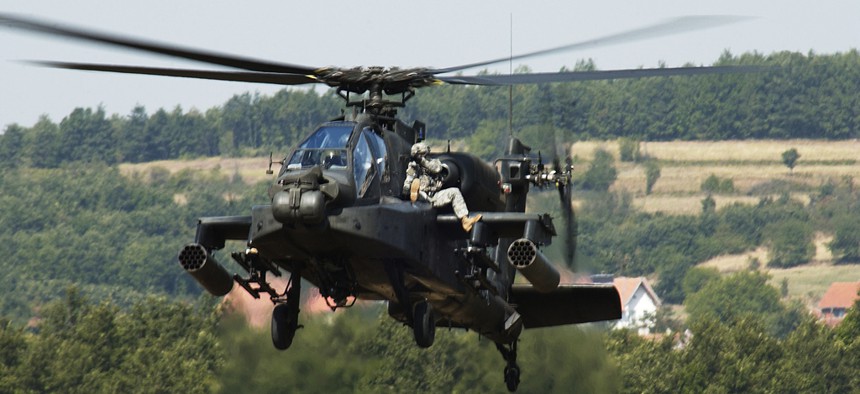
Two soldiers from the Multi-National Task Force ride on an Ah-64 Apache helicopter during an exercise at Camp Bondsteel, Kosovo. U.S. Army photo
The Army’s Next Engine War
Companies are gearing up for a lucrative competition to build a more powerful engine for the Army’s Blackhawk and Apache helicopters, but is it really needed? By Marcus Weisgerber
Over the past decade, the U.S. Army has relied on helicopters to move forces over mountainous terrain not reachable by vehicles in Afghanistan and across large swaths of deserts in Iraq. In many cases, powerful heavy-lift CH-47 Chinook tandem-rotor helicopters were needed to bring soldiers to high-altitude spots not reachable by Blackhawk utility helicopters.
The stealth Blackhawk helicopters that flew the elite members of Seal Team 6 on the mission that killed Osama bin Laden might not have had to make a refueling stop on the way back to their Afghan base if those helicopters had more powerful engines.
Now the Army is looking to field a stronger, more efficient engine for its Sikorsky Blackhawks and Boeing Apache attack helicopters, which could create a massive, multi-billion dollar competition down the road for American engine makers.
The Blackhawk and Apache are each powered by two General Electric T700 engines, which produce less than 2,000 shaft horsepower each. The goal is for the replacement engines to produce 3,000 shaft horsepower each which are also 25 percent more fuel efficient and fit in the current aircraft.
“The T700 is one of the best-run engine franchises ever,” said Richard Aboulafia, vice president for analysis at the Teal Group consulting firm.
But the top lesson learned from Iraq and Afghanistan is the need for more power from helicopters, he said.
Although the Army has not announced plans to move forward with the replacement effort, three companies—General Electric and a team of Honeywell and Pratt & Whitney—have been positioning themselves to compete. Both teams have been working on Army tech demos of their engines for several years.
GE has been working on a replacement for T700 since 2007 and has completed a number of tests, including sand testing, according to Mike Sousa, who heads GE’s Improved Turbine Engine Program.
(Related: As the Army's Future Takes Shape, So Does the Defense Market)
The Honeywell-Pratt team, which calls itself the Advanced Turbine Engine Company, touted recent tests of its own at the Association of the United States Army conference in Washington, D.C., on Monday.
“The second engine test ran extremely well and we are confident our solution will meet or exceed the Army’s current and future needs,” said Craig Madden, president of the Advanced Turbine Engine Company.
But the Army might not need a new engine for the Blackhawk or Apache if it moves forward with the Future Vertical Lift program, an effort to build a new family of helicopters to replace the Blackhawk, Apache, Chinook and Kiowa helicopters.
Depending on the timing of that program, it might not make sense for the Army to re-engine up to 3,000 Blackhawks and Apaches.
“Unlike the engine war [of the 1980s] where you really did have a problem, this is a series of solutions in search of a problem,” Aboulafia said.
The Teal Group
The original “Great Engine War” took place between Pratt & Whitney and General Electric in the 1980s. At the time, Pratt made the F100, which powers the F-15 Eagle and F-16 Fighting Falcon. As the sole supplier for the Air Force’s two premiere fighter jets, the company had a monopoly, leading to high costs for maintenance and replacement parts. There were also performance issues with the engine.
The Pentagon then decided it would hold a competition to build engines for the F-15 and F-16, which led to the creation of the General Electric F110 engine. The competition led to lower maintenance costs and better reliability for the Defense Department and is heralded as one of the Pentagon’s greatest procurement successes.
A second engine war emerged in recent years over the power plant for the expensive F-35 Joint Strike Fighter. The primary engine for the jet—the F135—is built by Pratt and Whitney. The Pentagon ran a second engine program—the F136, built by a General Electric and Rolls-Royce team—but canceled that effort in 2011, saying it could no longer afford the project.





